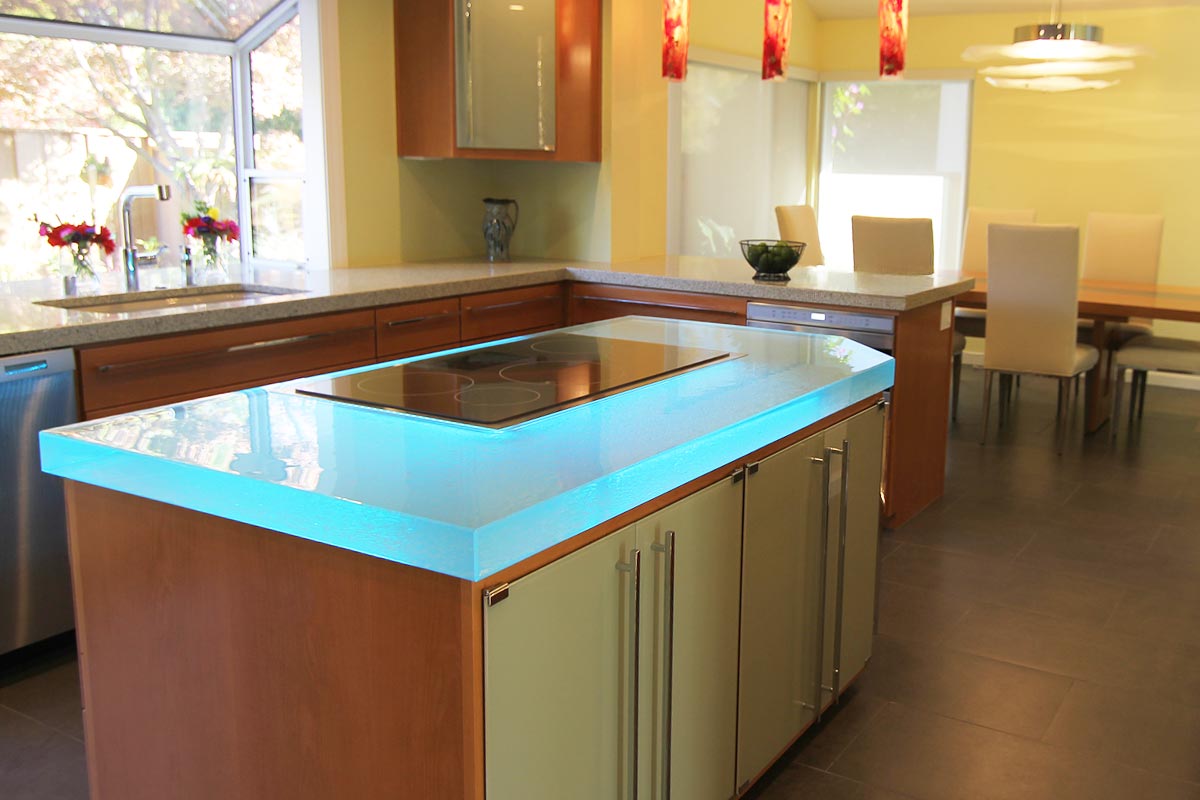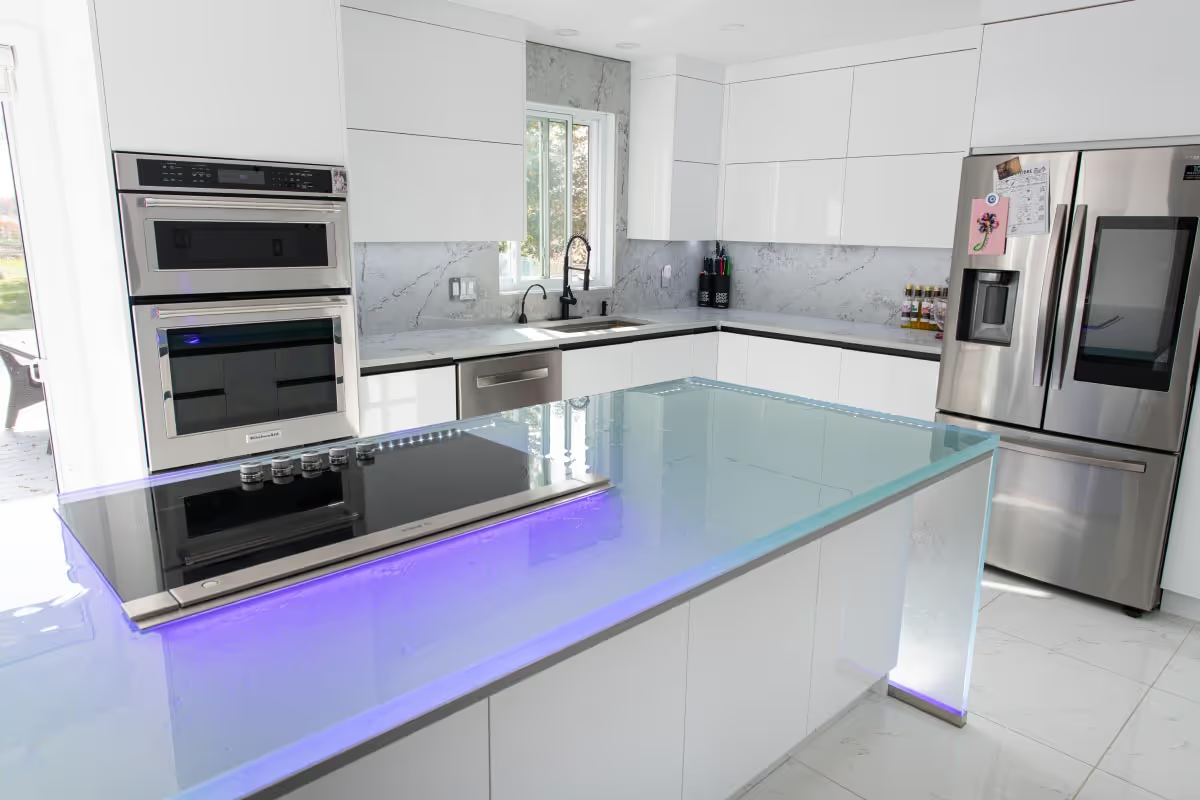(North American Edition, 2025)
A countertop is more than a working surface, it sets the tone for a kitchen, bathroom, or bar as much as any cabinetry or lighting choice. In North America, granite, engineered quartz, and solid wood have dominated for decades. Yet in the past 10–15 years, architectural glass has moved from an avant-garde experiment to a recognized high-end option.
Why? Because modern structural glass combines aesthetics with performance. It matches the strength of stone, surpasses it in hygiene, and allows for design freedom that natural materials cannot offer. In 2025, glass is no longer fringe, it’s a premium upgrade, seen in luxury kitchens from Manhattan to Vancouver, spa bathrooms in Scottsdale, and LED-lit poolside bars in Miami.

The Rise of Glass Countertops in North America
Glass countertops first emerged in the 1990s, mainly imported from Europe. Their adoption was slow due to high costs, limited thickness, and misconceptions about fragility. Over time, technological breakthroughs changed that perception and opened the door to mainstream use:
- Tempering technology meeting ANSI Z97.1 & ASTM C1048 safety glass standards.
- Laminated safety glass with CSA A440 compliance, preventing shards upon impact.
- Kiln-cast/fused slabs up to 4 inches thick, pioneered in Canada by ThinkGlass, enabling textures, LED integration, and unprecedented durability.
Today, according to the NKBA 2024 Kitchen Trends Report, glass countertops appear in 8–10% of U.S. luxury kitchens and 12–14% of Canadian high-end projects. Growth is driven by multi-residential towers, hospitality design, and the boom of outdoor living spaces.
Why Choose a Glass Countertop?
The appeal of glass is twofold: it brings aesthetic brilliance and performance advantages.
Aesthetic & Design Advantages
- Light Transmission: Glass can transmit up to 90% of visible light, producing depth and glow.
- Optical Illusion: With 2–4” edges, it refracts light like water or ice, appearing luminous.
- Unlimited Customization: Pigments, textures, integrated LEDs, and organic shapes, all possible in glass, unlike stone.
Performance Advantages
- Non-Porosity: Nearly 0% water absorption, versus granite (~0.2–0.4%) or concrete (~5–6%).
- Strength: Compressive strength above 25,000 psi; Mohs hardness ~5.5–6.0.
- Thermal Resistance: Withstands swings and outdoor use if edges are finished properly.
- Hygiene: NSF/ANSI Standard 51 approved, bacteriostatic, and easy to sanitize.
- UV Resilience: Low-iron formulations resist yellowing under exterior UV conditions.

Where Glass Performs Best
Beyond strength, thickness changes perception. A sleek 3/8” countertop feels different from a 4” sculptural slab.
Climate and Performance
North American climates pose challenges, but properly fabricated glass excels.
- Freeze–Thaw: Cast glass tested to ASTM C1026 performs in -30°C Canadian winters.
- UV Load: Low-iron formulations maintain 95% clarity after five years in Florida sun.
- Thermal Shock: Withstands ~40°C sudden shifts, crucial for fire-integrated counters.
Why ThinkGlass is the Market Leader
ThinkGlass, based in Quebec, has set the benchmark for luxury cast glass countertops across North America.
- Made in Canada, Installed Everywhere: Specialist handling across the U.S. and Canada.
- Exclusive Textures: Proprietary molds inspired by ice, water, and stone.
- Lighting Expertise: LED channels (RGB or white) for dynamic effects.
- Compliance: Meets ANSI, ASTM, and CSA safety codes.
- Sustainability: Fully recyclable, with reclaimed waste from fabrication.
Pros and Cons at a Glance
If stone is permanence and wood is warmth, glass is light captured in solid form. In North America’s 2025 design landscape, where personalization, hygiene, and drama are priorities, glass delivers all three.
With its unmatched durability, artistry, and ability to integrate light, ThinkGlass has defined what a glass countertop can be. Whether glowing in a Manhattan penthouse or crowning an outdoor spa in Whistler, a cast glass countertop is not just a surface. It is functional art, designed for decades of beauty and use.
Are glass countertops able to withstand the drastic seasonal variations in Québec's climate?
Indeed, ThinkGlass worktops are designed to function dependably in the face of Quebec's notable seasonal temperature fluctuations. Because of our patented glass-casting process, the glass is thermally stable through harsh winter freezes and hot, muggy summers. Our countertops, in contrast to conventional tempered glass, are constructed from kiln-cast glass that is cooled under controlled conditions, which lowers internal stress and improves stability over time. Our products are made in Laval with a thorough awareness of the local climate, guaranteeing their durability and resistance to thermal shock and abrupt temperature changes. This makes them perfect for outdoor living areas that need to endure the erratic weather in Quebec, as well as indoor kitchens and bathrooms.
In comparison to other popular surfaces like granite or quartz, how much does a ThinkGlass countertop cost?
ThinkGlass countertops are expensive because they are regarded as a high-end, luxurious surface. Every ThinkGlass countertop is handcrafted, designed, and manufactured to order in our Québec facility, unlike mass-produced granite or quartz slabs. The artistry, material quality, and available personalization options are all reflected in the price. A distinctive, sculptural surface with design and aesthetic value that traditional stone cannot match is what you get, even though the initial investment may be higher than that of quartz or granite. ThinkGlass countertops also offer long-term value for discriminating homeowners and designers looking for something genuinely unique because they are extremely durable, require little upkeep, and do not stain.
Are glass countertops safe and functional for busy kitchens?
Glass countertops are incredibly useful for daily use, despite their sleek and contemporary appearance. Because the surface is non-porous, it is easy to clean and resistant to bacteria. High-quality glass is far more resilient than most people realize; it can withstand heat, impacts, and repeated use. Edges are polished and smoothed for increased comfort and safety, and textured finishes can be selected to increase traction and lessen obvious smudging. Because of this, they're perfect for modern kitchens as well as commercial or residential settings where hygienic conditions and durability are important considerations.
How durable is glass as a countertop material over time?
Glass countertops are incredibly durable when made with the right reinforcement and kiln-casting techniques. Even after years of use, they don't chip, crack, or get stained. Even though no surface is completely impervious to scratches, this kind of glass resists normal wear well, especially if a matte or textured finish is chosen. Its non-porous nature prevents the surface from absorbing liquids or oils, so it will remain clear and shiny over time without becoming discolored. It can last for decades in its original splendor with little care.




